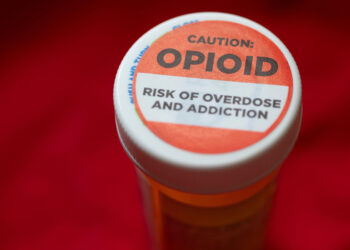Orlando, Fla — A surge in mortality due to thyroid storm occurred in the US during 2020-2021, likely partially, but not entirely, due to the COVID-19 pandemic, a new analysis of people hospitalized with thyrotoxicosis in the National Inpatient Sample (NIS) between 2016 and 2021 showed.
However, “the increased mortality observed was not solely attributable to COVID-19 infection. Critical comorbid conditions markedly heightened the risk of death,” study author Muhammad Sohaib Asghar, MD, a resident physician at AdventHealth, Sebring, Florida, told Medscape Medical News.
“This underscores the importance of early recognition and aggressive management of thyrotoxicosis, especially during healthcare system stressors such as pandemics,” said Asghar.
The condition — an endocrine emergency of extreme hyperthyroidism — commonly occurs in people with Graves’ thyrotoxicosis but is often precipitated by a secondary inciting factor such as infection or cardiac event, explained co-study author, Shehar Bano, MD, a resident physician at AdventHealth, Sebring, Florida, who presented the results at American Association of Clinical Endocrinology (AACE) Annual Meeting 2025.
Racial and demographic factors appeared to play a role in the development of thyroid storm among those with thyrotoxicosis, with higher rates among ethnic minorities and those of lower socioeconomic status, Bano added.
Given the high mortality risk in patients with thyrotoxicosis with severe systemic illness, Asghar noted, “clinicians should prioritize early risk stratification and consider prompt escalation of care. Tailored treatment plans and closer monitoring of patients with high-risk features can potentially improve outcomes, particularly in resource-limited or high-stress clinical settings.”
“These findings highlight the need for a multidisciplinary approach and proactive management of comorbidities in this patient population,” he added.
Thyrotoxicosis Trends: Many Risk Factors Identified
The study population included individuals aged 18 years or older in the NIS who had ICD-10 codes for thyrotoxicosis (E.05) regardless of cause, excluding those with a concomitant diagnosis of thyroiditis. Of the 186,474 patients included in the analysis (mean age, 60.91 years; 73% women), 97.83% were discharged alive while 2.17% died in hospital.
A total of 3800 patients with thyroid storm (2.04% of the study population) were identified. Patients with thyroid storm were significantly younger (mean age, 47 years vs 61 years), had greater lengths of hospital stay (7 days vs 5 days), and higher inflation-adjusted cost of stay (P < .001).
There was no gender predisposition in relation to thyroid storm (P = .61), but those with it were more likely Black or Hispanic individuals (P < .01), and to be on Medicaid or self-paying. They were also more likely to live in low socioeconomic ZIP codes (P < .01) and the US South region (P < .01), and to be admitted in Government non-federal hospitals (P < .01).
Those with thyroid storm were significantly more likely to have a long list of concurrent diagnoses, including coagulopathy, drug abuse, history of heart failure with systolic component instead of diastolic, mild liver disease, peripheral vascular disease, weight loss, sepsis, septic shock, cardiogenic shock, rheumatic heart disease, and non-ST-elevation myocardial infarction (P < .001 for all).
The list also included atrial arrythmias, respiratory failure, invasive ventilation, tracheostomy, cardiac arrest, acute heart failure, pneumonia, use of mechanical circulatory support, supraventricular and ventricular tachycardia, mitral valve disease, chronic liver disease, percutaneous endoscopic gastrostomy tube placement, acute venous thromboembolism, and pericardial effusion/pericarditis (P < .001, except for pneumonia where P = .001).
Over the entire study period, age-adjusted mortality per 100,000 hospitalizations was 6825 among those with thyroid storm vs 3601 for those without, Bano reported.
For those with thyroid storm, in-hospital mortality appeared to be rising even prior to the COVID-19 pandemic, with a surge beginning in 2019. The percentages were 2.88% in 2016, 6.00% in 2017, 4.78% in 2018, 6.37% in 2019, 6.61% in 2020, and 7.58% in 2021 (P < .001 for trend).
Among those without thyroid storm, in-hospital mortality stayed relatively steady until the pandemic, ranging from 1.78% to 1.82% between 2016 and 2019, then jumping to 2.48% in 2020 and 2.87% in 2021 (P for trend < .001).
Annual age-adjusted mortality rates per 100,000 hospitalizations were roughly similar between those with and without thyroid storm in 2019, 3442 and 3107, respectively. In 2020, those numbers rose to 7629 for those with thyroid storm vs 4754 for those without. In 2021, they were 12,859 and 4539, respectively.
“With future National Inpatient Sample data releases in 2023 and beyond, we should expect this mortality rate to be declining,” Asghar told Medscape Medical News.
Impressive Sample Size
Asked to comment, session moderator Sean Ho Yoon, MD, assistant professor of clinical medicine at Donald and Barbara Zucker School of Medicine at Hofstra/Northwell, Long Island, New York, told Medscape Medical News, “the study has a limitation because it is not randomized, case controlled, or even blinded. It is a retrospective study. So there’s an inherent confounding.”
But, Yoon added, those limitations were somewhat mitigated by the large sample size from NIS, which includes 86% of healthcare centers in the US.
“I was impressed by the fact that the sample size is really big. Thyrotoxicosis may be commonly seen, but thyroid storm is not,” he said. Having a 3800-patient sample size “was actually impressive.”
Regarding the socioeconomic differences, Yoon said, “For clinicians, the challenge is the barriers for them to have access to healthcare because thyroid storm, especially, is preventable by just following routinely with doctors and taking the medication or definitive treatment for the hyperthyroidism.”
Bano, Asghar, and Yoon have no disclosures.
Miriam E. Tucker is a freelance journalist based in the Washington, DC, area. She is a regular contributor to Medscape, with other work appearing in the Washington Post, NPR’s Shots blog, and Diatribe. She is on X (formerly Twitter) @MiriamETucker and BlueSky @miriametucker.bsky.social.
Source link : https://www.medscape.com/viewarticle/thyroid-storm-deaths-rose-covid-19-other-risk-factors-2025a1000fwd?src=rss
Author :
Publish date : 2025-06-13 12:29:00
Copyright for syndicated content belongs to the linked Source.














